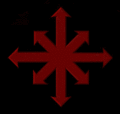- Symbol of Chaos
-
The Symbol of Chaos originates from Michael Moorcock's Eternal Champion stories. In them, the Symbol of Chaos comprises eight arrows in a radial pattern. In contrast, the symbol of Law is a single upright arrow. It is also called the Arms of Chaos, the Arrows of Chaos, the Chaos Star or the Symbol of Eight.
Moorcock has stated that he conceived this symbol while writing the first Elric of Melniboné stories in the early 1960s. It was subsequently adopted into the pop-cultural mainstream, turning up in such diverse places as modern occult traditions and role-playing games.
There are a number of traditional symbols that have the same geometrical pattern as Moorcock's symbol of Chaos, such as any of various eight-pointed stars (like this one from a Greek vase from the fifth century BCE), the star of Ishtar/Venus, the Eastern Dharmacakra and the Wheel of the Year, but none of these were symbols of chaos and their limbs are not arrows.
Furthermore, the '8' of Wands in Aleister Crowley's Thoth Tarot deck features prominently an eight-pointed star with arrows at the ends. Crowley described the card as representing "energy" scattering at "high velocity" that had managed to create the depicted eight-pointed figure. [1]
Moorcock says, about his version [2] —
The origin of the Chaos Symbol was me doodling sitting at the kitchen table and wondering what to tell Jim Cawthorn the arms of Chaos looked like. I drew a straightforward geographical quadrant (which often has arrows, too!) – N, S, E, W – and then added another four directions and that was that – eight arrows representing all possibilities, one arrow representing the single, certain road of Law. I have since been told that it is an "ancient symbol of Chaos" and if it is then it confirms a lot of theories about the race mind. … As far as I know the symbol, drawn by Jim Cawthorn, first appeared on an Elric cover of Science Fantasy in 1962, then later appeared in his first comic version of Stormbringer done by Savoy [ISBN 0-7045-0226-7].An even-more-chaotic asymmetrical representation was by Walter Simonson in the Michael Moorcock's Multiverse comic (and subsequent graphic novel: ISBN 1-56389-516-1).
Games
The symbol's first appearance in a commercial role-playing game (RPG) was in TSR's Dungeons & Dragons supplement, Deities & Demigods [1] which included the gods, monsters, and heroes from Moorcock's Elric books as one of 17 mythological and fictional "pantheons". Copyright problems led to its omission from later editions.[citation needed]
It then turned up quite naturally in Chaosium's Stormbringer RPG (one edition of which was published as Elric!).[2] The 1987 edition of Stormbringer was published jointly by Chaosium in the U.S. and Games Workshop (GW) in the UK.
Moorcock's eight-arrow symbol of Chaos was subsequently arrogated by GW and became a frequent graphic element in their own Warhammer and Warhammer 40,000 games and the related miniature figures.
It also shows in Vampire: The Masquerade - Bloodlines, in the home of Aleister Grout, the Malkavian primogen.
It further appears on an item called a "chaos device" in Heretic and HeXen
Modern traditions
The eight-arrow symbol of Chaos is used in chaos magic, as is its 3D analog, the Chaosphere.
Alternative symbols of chaos (owing nothing to Moorcock) include the Sacred Chao of Discordianism and The Five Fingered Hand of Eris.
It has also appeared in Bungie's Xbox 360 game Halo 3: ODST as an emblem for playable multiplayer characters.
It has also appeared in a lot of artwork by Shock Rock/Thrash Metal band GWAR. It has been featured on the cover of their album This Toilet Earth and in the inserts of other albums along with being used on much of their merchandise and early flyers.
It has also appeared as album artwork on the albums of Black Metal band 1349, including the album Liberation
References
Categories:- Symbols
- Religious symbols
- Michael Moorcock's Multiverse
- Chaos magic
Wikimedia Foundation. 2010.



